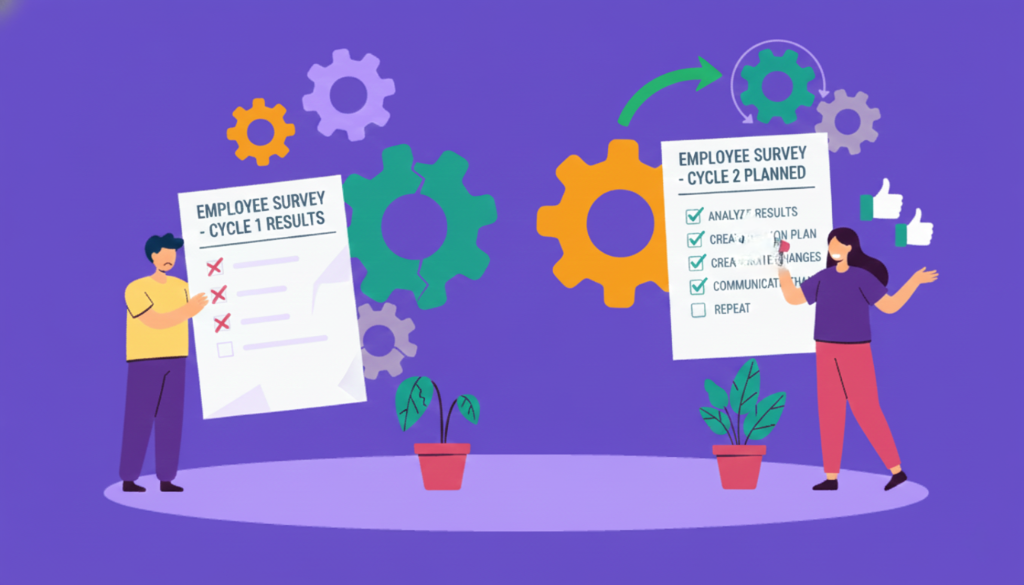Employee Retention Survey Questionnaire with 30+ Questions to ask Your Employees

A Global Employee Recognition and Wellness Platform
Losing a good employee hurts. A lot. You put in the effort to find them, bring them on board, and help them grow. They learn the ropes, build connections, and become a vital part of your team. Then, suddenly, they leave. This isn't just tough; it costs real money and time. Think about it: replacing an employee can cost anywhere from half to twice their yearly salary, depending on the job. For leadership roles, it can be over 200%. That's a huge expense, as studies from Gallup confirm.
So, how do you get ahead of this? How do you really understand what's happening with your team before someone quits? The answer is a powerful, yet often underused, tool: the employee retention survey. It's not just another HR task; it's your early warning system for keeping your best people.
In this guide, we'll break down employee retention surveys. We'll explain what they are, show you their big benefits, discuss the best times to use them, and give you over 30+ smart questions to ask.
Let's dive in!
What Is an Employee Retention Survey?
Simply put, an employee retention survey is a confidential way to ask your current employees why they choose to stay with your company. It's about understanding what makes your company a good place to work for them long-term.
It's important to know this is different from an employee engagement survey or an exit interview. An engagement survey looks at how connected and enthusiastic an employee feels about their work right now. While engagement definitely helps with retention, a retention survey focuses specifically on the reasons people stick around. An exit interview, on the other hand, happens after someone has decided to leave. It's helpful to learn why they left, but the decision is already made.
A retention survey is proactive. It helps you find out what's going on before an employee even thinks about quitting. It digs into things like chances for career growth, pay and benefits, support from managers, company culture, and work-life balance. By focusing on what makes people stay, HR leaders, CHROs, and managers can spot potential problems early and act fast.
8 Benefits of Conducting Retention Surveys

Why bother with these surveys? The payoff can be huge, going beyond just cutting down on people leaving. Here are some clear benefits:
1. Saves Money
The most direct benefit is financial. By finding and fixing issues that make people leave, you save a lot on replacement costs. As mentioned, replacing an employee is expensive. Preventing just a few people from leaving because of survey insights can save a significant amount of money that you can then put back into growing your business or helping your employees.
2. Solves Problems Early
Retention surveys act like an early alert system. Instead of reacting when someone quits, you get clues about potential problems – maybe issues with management, not enough growth opportunities, or unhappiness with pay – before they get too big. This helps HR and leaders fix the root causes, making the workplace more stable. You move from putting out fires to preventing them.
3. Boosts Employee Engagement and Morale
When employees see that their feedback is genuinely asked for and acted on, it shows them their opinions matter. This builds trust and shows you care about their well-being and growth. Feeling heard makes people more engaged. Research has shown that organizations with highly engaged employees enjoy 26% higher revenue per employee, as well as 13% greater total returns to shareholders.
4. Improves Leadership
Survey results give clear data on how managers and leaders are doing. Are managers giving good support? Are they talking about career paths? This feedback is gold for leadership training, showing where managers might need help to improve how they keep their teams.
5. Creates Better HR Plans
You no longer have to guess what employees want. Retention survey data gives you a clear path to fine-tune your HR policies, benefits, pay scales, and training programs. You can invest in what truly matters most to your team, making your HR budget work harder.
6. Helps Diversity, Equity, and Inclusion (DEI)
These surveys can reveal if different groups of employees have different experiences. By looking at survey data by group (while keeping it private), you might find that certain employees feel less recognized or have fewer growth chances. This helps you target specific DEI challenges and create a fairer workplace for everyone, which helps keep all employees.
7. Identifies "Quiet Quitting"
Quiet quitting – where employees do the bare minimum and mentally check out – can slowly harm your company. Retention surveys, especially through open-ended questions about motivation, can show signs of this disengagement before it leads to someone actually leaving. This lets you step in and re-engage them.
8. Strengthens Your Company Brand
A company known for truly listening to its employees and acting on their feedback builds a stronger reputation, both inside and out. This good name helps attract top talent, creating a positive cycle: a good culture leads to good retention, which then helps you hire even better people.
Recommended Read: 10 Ways to Create a Great Company Culture
When to Conduct an Employee Retention Survey?
The timing of your surveys is almost as important as the questions you ask. Being flexible and considering your company's situation will give you the best information.
Regular Check-ins:

-
Quarterly surveys: These are like quick pulse checks. They help you spot new issues fast and show you're always listening. This works well in quickly changing environments.
-
Bi-annual surveys: Twice a year, give enough time to put changes in place and see their effects, preventing "survey fatigue" while still giving regular insights.
No matter the frequency, be consistent. Employees will expect these chances to share feedback, and you'll build up data over time to track trends.
Special Times to Survey:
Besides a regular schedule, there are specific times when a retention survey (or a shorter "pulse" survey) makes smart business sense:
-
After Big Company Changes: Things like mergers, big restructures, or new leaders can make employees feel unsure. A survey after these events can check how people feel and help leaders address worries to prevent people from leaving. For example, after a merger, you might ask about how well teams are integrating.
-
After New HR Programs: If you've just rolled out a new pay plan, benefits, or training program, a retention survey can tell you if employees are happy with it and if it's having the desired effect on retention.
-
During High Turnover: If a certain department or the whole company suddenly sees more people leaving, a quick survey can help you find out why. This allows for fast action.
-
During Economic Shifts: External factors, like the economy, can change how employees feel. In a tough job market, people might care more about job security. In a booming one, growth chances and pay might be key. A survey at these times helps you understand your team's current priorities.
-
Around Key Business Cycles: For businesses with busy seasons, surveying during or after peak periods can show how workload affects burnout and retention.
-
Employee Milestones: While not full surveys, many companies do short check-ins at 90 days, 1 year, 3 years, or 5 years. These "stay interviews" help understand an employee's journey and spot any concerns early.
What to Ask: 30+ Employee Retention Survey Questions
Asking the right questions is key to a powerful retention survey. To get a full picture, it's best to mix different types of questions.
1. Yes/No Questions: Quick Checks for Clear Answers
These questions are great for getting direct, easy-to-measure answers. They help you quickly see clear trends or problem areas.
When to use: When you need a simple "is this true for you?" answer.
Examples:
-
Do you feel you're paid fairly for your work?
-
Do you have clear chances to grow your career here?
-
Does your manager notice and appreciate your work?
-
Do you feel like you belong at this company?
-
Does your manager genuinely care about your well-being?
-
Do you have the right tools and resources to do your job well?
-
Is your workload manageable?
-
Do you feel the company's values match your own?
-
Are you happy with your current benefits (like health and retirement)?
-
Do you see yourself working here one year from now?
2. Scaled Questions: Measuring How People Feel
Scaled questions (like "Strongly Disagree" to "Strongly Agree," or a 1-5 rating) help you measure how strongly someone feels. They give you more detailed information than just Yes/No, showing you how much an employee agrees or disagrees. This helps find out if an area is "mostly good" or "really bad."
When to use: To measure how satisfied people are with things like work-life balance, leadership, or culture, and to track changes over time.
Examples (using a 5-point scale: 1=Strongly Disagree, 5=Strongly Agree):
Pay & Benefits:
-
I believe my pay is competitive with similar jobs in our industry.
-
I'm happy with the company's overall benefits package.
-
I understand how my performance affects my pay and career path here.
Career Growth & Learning:
-
I have enough chances to grow professionally and learn new skills at this company.
-
My manager actively supports my career goals.
-
I see a clear path for moving up in the company.
Manager & Leader Support:
-
My manager gives me helpful feedback to improve.
-
My manager supports me in handling my workload.
-
I trust our senior leaders to make good decisions for the company's future.
-
My manager clearly explains what's expected of me.
Work-Life Balance & Well-being:

11. I can keep a healthy balance between my work and personal life.
-
I feel the company truly cares about my well-being.
-
I have flexibility in my work schedule when I need it.
Culture & Workplace:
-
I feel respected and valued by my coworkers.
-
Our company culture makes me feel like I belong and am included.
-
I feel comfortable sharing my ideas and opinions openly.
-
I believe the company does a good job promoting diversity, equity, and inclusion.
Recognition & Appreciation:

18. I feel my hard work and contributions are recognized by the company.
- My manager regularly acknowledges good performance.
Overall Happiness & Intent to Stay:
-
Overall, I'm happy with my job at this company.
-
I would tell others this is a great place to work.
-
I can see myself working at this company for the next two years.
3. Open-ended Questions: Getting Detailed Answers
These questions are great for getting rich, detailed information. They let employees explain things in their own words and offer specific suggestions. While harder to count, the answers often show the "why" behind the numbers from your other questions.
When to use: To understand the full story, find unexpected issues, or get specific ideas for improvement.
Examples:
-
What's one main thing that makes you want to stay with our company right now?
-
What's the main reason you might consider looking for a new job elsewhere?
-
What specific actions could your manager take to better support your growth or well-being?
-
If you could change one thing about our company culture, what would it be and why?
-
What kind of training or development would help you the most?
-
How do you feel about the feedback you get, and how could it be better?
-
What parts of your job do you find most rewarding?
-
Are there any specific benefits or perks that would make you much happier here?
-
What could the company do to improve work-life balance for employees?
-
Is there anything else you'd like to share about your experience working here?
Using a mix of these question types builds a strong survey that gives you both clear numbers and the rich details needed to act on your employees' feedback effectively.
How to Analyze Your Survey Results?

Getting the data is just one part; the real value comes from making sense of it. This turns raw numbers and comments into smart actions that can boost your retention.
1. Start Simple: Who Replied and General Feelings
Participation Rate: First, check how many people completed the survey. A higher rate (aim for 70% or more for bigger companies) means your results are more reliable. A low rate might mean people are tired of surveys, don't trust the process, or didn't hear enough about it.
Overall Positive Scores: For questions with scales, look at the "positive" score – usually the percentage of people who picked "Agree" or "Strongly Agree." This gives you a quick overview of satisfaction in areas like "Manager Support" or "Work-Life Balance." Spot the areas with the highest and lowest positive scores.
2. Dig Deeper: Finding Problem Areas and Trends
Focus on the Low Scores: Pay close attention to the lowest scores on your scaled questions (like "Strongly Disagree") and "No" answers. These are your red flags, showing serious unhappiness that could lead to people leaving.
Break Down Your Data (More on this next): Don't just look at the company as a whole. Split your data by department, team, how long people have worked there, or other groups. A low score on "Career Growth" might be true for the whole company, or it might be a problem just in one department.
Look at Trends Over Time: If you've done surveys before, compare current results to past ones. Are scores getting better or worse in certain areas? This long-term view helps you see if your past efforts worked and what new concerns are popping up.
3. Find the "Why": Analyzing Open-Ended Comments

Group Similar Ideas: Open-ended answers are full of valuable details. Read through them (or use software to help) and group comments with similar themes. For example, comments about "no mentors" or "feeling stuck" might all fall under a "Career Development" theme.
Count the Themes: Once you have themes, you can count how often each one appears. If 40% of comments mention "poor communication from leaders," that's a strong signal.
Look for Specific Examples: These comments often give clear examples of problems. Someone might write, "I asked for project management training three times last year, but nothing happened." This gives you a direct example of a lack of development support.
4. Connect the Dots: Compare to Engagement or Exit Surveys (if you have them)
If you also do engagement surveys or exit interviews, comparing the data can give you powerful insights. Do the problems found in retention surveys match what people say when they leave? If yes, it confirms your survey is accurate, and fixing those issues could reduce future turnover.
Employee Retention Survey Best Practices
Running a good employee retention survey involves more than just asking the right questions; it's about the whole process, from planning to taking action. Here are key tips to get the most useful information and make positive changes:
-
Explain Why and What Happens Next: Before starting, clearly tell employees why you're doing the survey and how their feedback will be used. After the survey, share the main findings (even the tough ones) and, most importantly, what specific steps you'll take. Being open builds trust. As HR expert Josh Bersin often says, "The biggest reason employees don't trust surveys is because they don't see any action from them."
-
Ensure Anonymity and Privacy: This is a must-have. Employees need to feel completely safe to give honest feedback without worrying about getting in trouble. Use a reliable survey tool like Vantage Pulse that promises anonymity, and be clear about your privacy rules. Avoid questions that could accidentally reveal who someone is, especially in smaller teams.
-
Keep it Short and Focused: Respect your employees' time. While you want good data, a long, rambling survey will make people tired and less likely to finish it. Aim for a survey that takes about 10-15 minutes to complete. Focus on questions directly related to why people stay or leave.
-
Test Your Survey First: Before launching to everyone, test the survey with a small, diverse group of employees. This helps you find any confusing questions, technical issues, or problems with how the survey flows.

-
Combine with Other Data: Don't look at survey results by themselves. Compare them with other HR numbers like actual turnover rates (by department or manager), performance review results, promotion rates, and exit interview feedback. This complete view gives you a much better picture.
-
Train Managers for Follow-Up: Managers are crucial. Give them access to their team's anonymous results and teach them how to discuss feedback constructively, figure out what their team needs to do, and share follow-up plans. Their involvement is key for building trust and making changes at the team level.
-
Prioritize and Take Action: You can't fix everything at once. Find the top 2-3 most important issues from your analysis. Create clear, measurable action plans for these areas, assign who's responsible, and set deadlines. Start with changes that will make a big impact and are doable to build momentum and show employees their feedback matters.
-
Repeat and See the Impact: Retention surveys aren't a one-time thing. Do them regularly and use later surveys to see if your actions worked. Are the scores getting better in the areas you focused on? This ongoing feedback loop shows you're committed and helps you keep making your retention plans better.

Things to Avoid:
-
Surveying Without Acting: This is the quickest way to lose employee trust and make them tired of surveys. If you ask for feedback, you must be prepared to do something about it.
-
Ignoring Bad Feedback: It might be uncomfortable, but negative feedback is your most valuable insight. Don't skip over it; face it directly.
-
Blaming Employees for Bad Results: The survey reflects the company's health. If results are poor, it points to problems with the system or leadership, not just employees complaining.
-
Too Many Surveys: Too many surveys, or surveys that are too long, will lead to fewer people taking part and less engagement.
-
Not Following Up: Employees need to know their feedback was heard and what steps are being taken. Not communicating after the survey is almost as bad as not acting on the results at all.
Conclusion
The cost of people leaving – both in money and how it affects your team – is too high to ignore. While many things affect an employee's decision to stay or go, the best way to understand and improve retention is by simply asking your people.
Employee retention surveys are much more than just collecting data. They are a powerful way to show you're listening. They tell your employees that their experiences, worries, and hopes matter. They give leaders, from HR to the CEO, clear, useful information to stop guessing and start making smart, data-driven plans.
Listening is the first important step; consistent, meaningful action is what builds lasting trust, boosts engagement, and ultimately ensures your best talent chooses to stay and thrive with you for the long run.










 >
>







